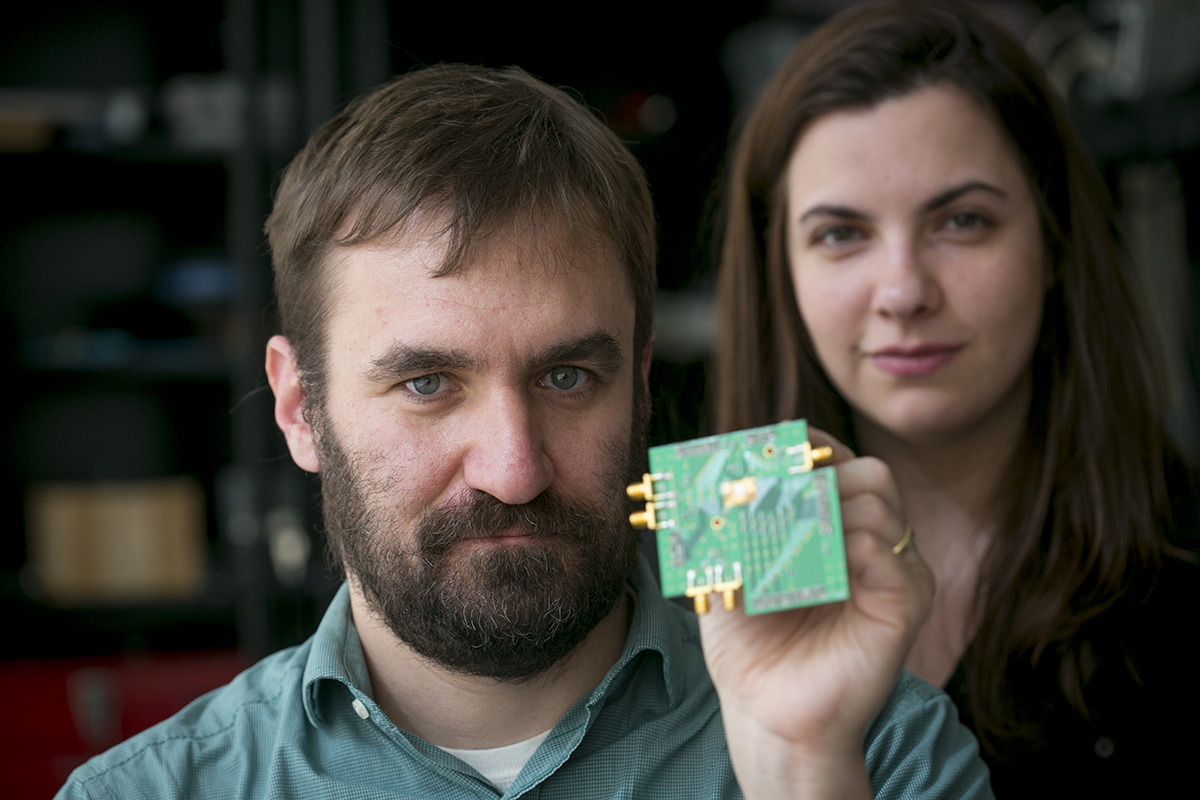Engineers devise two-way radio on a single chip
By Tom Fleischman

Two-way communication requires, of course, both send and receive capabilities. But putting them in the same device requires a filter between the send and receive circuits to provide signal isolation.
Without a significant filter, communication would be impossible.
“Your transmit signal is 1014 times stronger than your receive signal,” said Alyosha Molnar, associate professor of electrical and computer engineering (ECE). “That’s 100 trillion times stronger – that’s a really hard problem.”
But researchers in Molnar’s lab have offered up a solution.
Molnar and collaborator Alyssa Apsel, professor of ECE, have devised a method for both transmitting and receiving a radio signal on a single chip, which ultimately could help change the way wireless communication is done.
Their work is described in “A wideband fully integrated software-defined transceiver for FDD and TDD operation,” published online Jan. 27 in the Institute of Electrical and Electronics Engineers’ Journal of Solid-State Circuits. Doctoral student Hazal Yüksel and Dong Yang, Ph.D. ’15, are co-lead authors.
Separating the send and receive bands is difficult enough, but the problem is compounded by the ever-increasing number of bands in the latest devices. From GPS to Bluetooth to Wi-Fi, each band requires a filter to stop the strong transmit signals from drowning out reception.
Molnar and Apsel have come up with an ingenious way to separate the signals. Their idea lies in the transmitter – actually a series of six subtransmitters all hooked into an artificial transmission line. Each sends its signal at regular intervals, and their individually weighted outputs are programmed so that they combine to produce a radio frequency signal in the forward direction, at the antenna port, while canceling out at the receive port.
The programmability of the individual outputs allows this simultaneous summation and cancellation to be tuned across a wide range of frequencies, and to adjust to signal strength at the antenna.
“In one direction, it’s a filter and you basically get this cancellation,” Apsel said. “And in the other direction, it’s an amplifier.”
“You put the antenna at one end and the amplified signal goes out the antenna, and you put the receiver at the other end and that’s where the nulling happens,” Molnar said. “Your receiver sees the antenna through this wire, the transmission line, but it doesn’t see the transmit signal because it’s canceling itself out at that end.”
This work builds on research reported six years ago by a group from Stanford University, which devised a way for the transmitter to filter its own transmission, allowing the weaker incoming signal to be heard. It’s the theory behind noise-canceling headphones.
Unlike the Stanford work, the Cornell group’s subtransmitter concept will work over a range of frequencies – a positive in this age of scrambling for available frequencies that used to be the realm of over-the-air television.
“This wire is a fairly broadband structure,” Molnar said. “And the thing you do to make it work over a wide range of frequencies is just control those different subgains of the transmitters, to make this cancellation always happen.”
Instead of needing a filter for every band, signal separation can be controlled digitally. Upgrading to the latest version would be like updating an app – as simple as downloading the latest software.
“You could have a single device that can be anything,” Apsel said. “You wouldn’t have to buy a new piece of equipment to have the newest version of it.”
Other contributors included Changhyuk Lee, Ph.D. ’14, and doctoral students Zachariah Boynton and Thomas Tapen.
Financial support for this work came from the Defense Advanced Research Projects Agency.
Media Contact
Get Cornell news delivered right to your inbox.
Subscribe